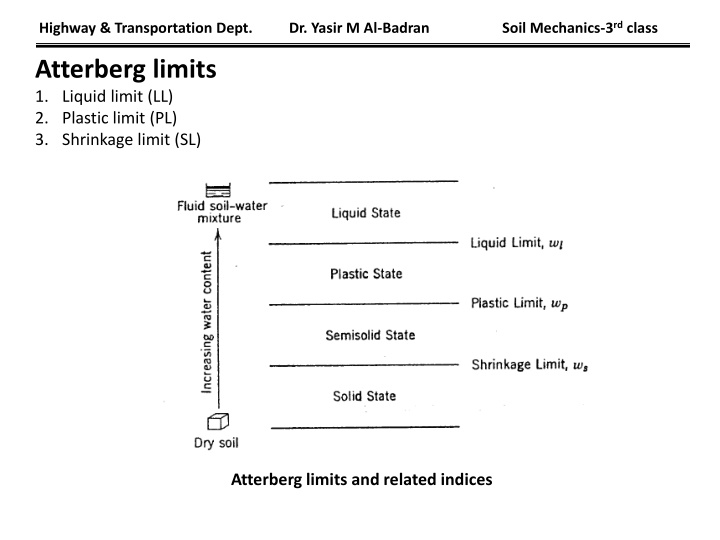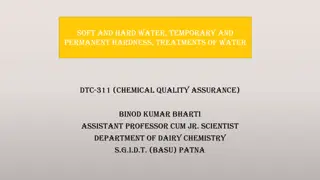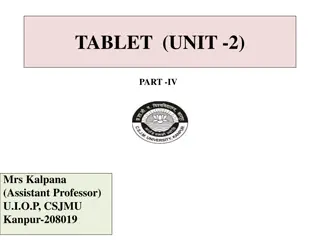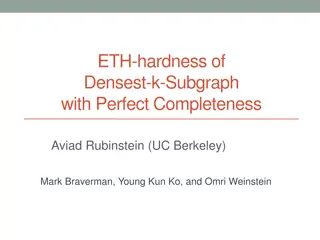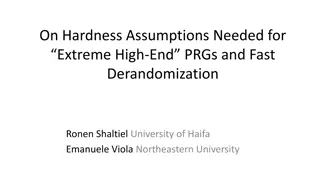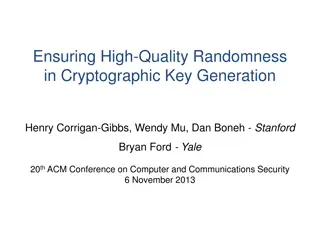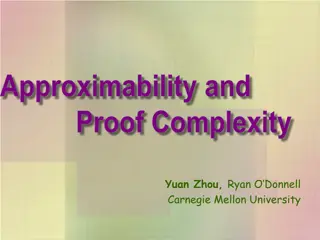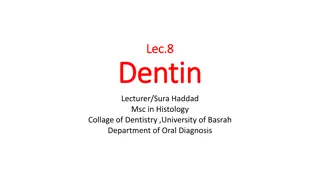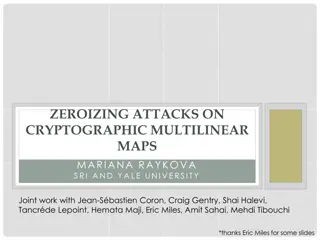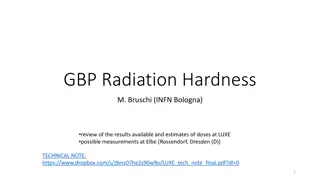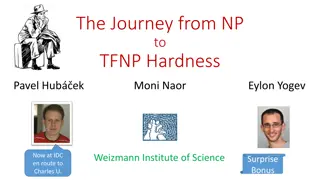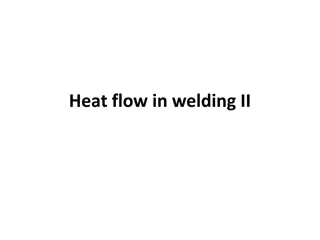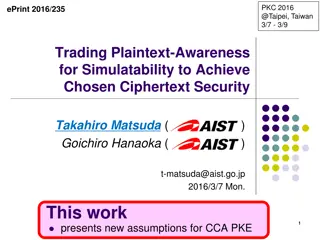Hardness Assessment of Cryptographic Assumptions
Delve into the assessment of the hardness levels of cryptographic assumptions such as factoring-based and dlog-based problems. Understand the security recalls, algorithms for factoring, and dlog algorithms for generic and specific groups. Gain insights into the optimal algorithms and the efficiency of elliptic-curve groups in enabling more efficient cryptography.
Download Presentation

Please find below an Image/Link to download the presentation.
The content on the website is provided AS IS for your information and personal use only. It may not be sold, licensed, or shared on other websites without obtaining consent from the author.If you encounter any issues during the download, it is possible that the publisher has removed the file from their server.
You are allowed to download the files provided on this website for personal or commercial use, subject to the condition that they are used lawfully. All files are the property of their respective owners.
The content on the website is provided AS IS for your information and personal use only. It may not be sold, licensed, or shared on other websites without obtaining consent from the author.
E N D
Presentation Transcript
Highway & Transportation Dept. Dr. Yasir M Al-Badran Soil Mechanics-3rd class Atterberg limits 1. Liquid limit (LL) 2. Plastic limit (PL) 3. Shrinkage limit (SL) Atterberg limits and related indices
Highway & Transportation Dept. Dr. Yasir M Al-Badran Soil Mechanics-3rd class Soil Classification The unified soil classification system AASHTO method 1-The unified soil classification system (USCS) According to the USCS the soil is divided either coarse-soil: Gravel (G) or Sand (S) or fine- soils: Silt (M) or Clay (C). The coarse-soils sub divide to well graded (W) or poor graded (P), and the fine-soils sub divide to high plasticity (H) for LL> 50% and low plasticity (L) for LL< 50%. Procedure The USCS needs the following values: Passing Sieve # 200 (Dia. 0.075 mm)--------sieve analysis Cu = D60/ D10 Cc = D302/ (D60 D10) LL & PL ------------ sieve analysis ------------ sieve analysis ------------ LL & PL tests
Highway & Transportation Dept. Dr. Yasir M Al-Badran Soil Mechanics-3rd class
Highway & Transportation Dept. Dr. Yasir M Al-Badran Soil Mechanics-3rd class
Highway & Transportation Dept. Dr. Yasir M Al-Badran Soil Mechanics-3rd class 2-AASHTO Soil Classification System The AASHTO Soil Classification System was developed by the American Association of State Highway and Transportation Officials, and is used as a guide for the classification of soils and soil-aggregate mixtures for highway construction purposes. The classification system was first developed by Hogentogler and Terzaghi in 1929, but has been revised several times since. AASHTO Soil Classification System (from AASHTO M 145 or ASTM D3282) General Classification Granular Materials (35% or less passing the 0.075 mm sieve) Silt-Clay Materials (>35% passing the 0.075 mm sieve) A-1 A-2 A-7 Group Classification A-3 A-4 A-5 A-6 A-1-a A-1-b A-2-4 A-2-5 A-2-6 A-2-7 A-7-5 A-7-6 Sieve Analysis, % passing 2.00 mm (No. 10) 50 max 0.425 (No. 40) 30 max 50 max 51 min 0.075 (No. 200) 15 max 25 max 10 max 35 max 35 max 35 max 35 max 36 min 36 min 36 min 36 min Characteristics of fraction passing 0.425mm (No. 40) Liquid Limit 40 max 41 min 40 max 41 min 40 max 41 min 40 max 41 min 11 min1 Plasticity Index 6 max N.P. 10 max 10 max 11 min 11 min 10 max 10 max 11 min Usual types of significant constituent materials stone fragments, gravel and sand fine sand silty or clayey gravel and sand silty soils clayey soils General rating as a subgrade excellent to good fair to poor subgroup is greater than LL - 30 - 6 - 7 A fo xedni yticitsalP . subgroup is equal to or less than the LL - 30 - 5 - 7 A fo xedni yticitsalP :( Note ( 1
